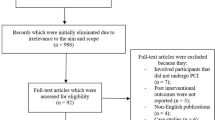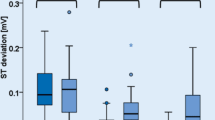Abstract
Background
Sleep-disordered breathing (SDB) has been recognized as an important risk factor for coronary artery disease (CAD). However, SDB was not fully examined, because sleep studies are limited. Nocturnal pulse oximetry has been suggested to be a useful tool for evaluating SDB. Therefore, the aim of this study was to investigate the influence of SDB assessed by nocturnal pulse oximetry on clinical outcomes in patients who underwent percutaneous coronary intervention (PCI).
Methods
We conducted a prospective, multicenter, observational cohort study, wherein SDB was assessed by finger pulse oximetry in patients who underwent PCI from January 2014 to December 2016. SDB was defined as 4% oxygen desaturation index of 5 and higher. The primary endpoint was major adverse cardiac or cerebrovascular event (MACCE), defined as a composite of all-cause mortality, acute coronary syndrome, and/or stroke.
Results
Of 539 patients, 296 (54.9%) had SDB. MACCE occurred in 32 patients (5.8%) during a median follow-up of 1.9 years. The cumulative incidence of MACCE was significantly higher in patients with SDB (P = 0.0134). In the stepwise multivariable Cox proportional model, the presence of SDB was a significant predictor of MACCE (hazard ratio 2.26; 95% confidence interval 1.05–5.4, P = 0.036).
Conclusions
SDB determined by nocturnal pulse oximetry was associated with worse clinical outcomes in patients who underwent PCI. Screening for SDB with nocturnal pulse oximetry was considered to be important for risk stratification in patients with CAD.



Similar content being viewed by others
References
Kasai T, Floras JS, Bradley TD (2012) Sleep apnea and cardiovascular disease: a bidirectional relationship. Circulation 126(12):1495–1510. https://doi.org/10.1161/circulationaha.111.070813
Floras JS (2014) Sleep apnea and cardiovascular risk. J Cardiol 63(1):3–8. https://doi.org/10.1016/j.jjcc.2013.08.009
Linz D, Woehrle H, Bitter T et al (2015) The importance of sleep-disordered breathing in cardiovascular disease. Clin Res Cardiol 104(9):705–718. https://doi.org/10.1007/s00392-015-0859-7
Peker Y, Hedner J, Kraiczi H, Loth S (2000) Respiratory disturbance index: an independent predictor of mortality in coronary artery disease. Am J Respir Crit Care Med 162(1):81–86. https://doi.org/10.1164/ajrccm.162.1.9905035
Mooe T, Franklin KA, Holmstrom K, Rabben T, Wiklund U (2001) Sleep-disordered breathing and coronary artery disease: long-term prognosis. Am J Respir Crit Care Med 164(10 Pt 1):1910–1913. https://doi.org/10.1164/ajrccm.164.10.2101072
Yumino D, Tsurumi Y, Takagi A, Suzuki K, Kasanuki H (2007) Impact of obstructive sleep apnea on clinical and angiographic outcomes following percutaneous coronary intervention in patients with acute coronary syndrome. Am J Cardiol 99(1):26–30. https://doi.org/10.1016/j.amjcard.2006.07.055
Lee CH, Sethi R, Li R et al (2016) Obstructive Sleep Apnea and Cardiovascular Events After Percutaneous Coronary Intervention. Circulation 133(21):2008–2017. https://doi.org/10.1161/circulationaha.115.019392
Turmel J, Series F, Boulet LP et al (2009) Relationship between atherosclerosis and the sleep apnea syndrome: an intravascular ultrasound study. Int J Cardiol 132(2):203–209. https://doi.org/10.1016/j.ijcard.2007.11.063
Weinreich G, Wessendorf TE, Erdmann T et al (2013) Association of obstructive sleep apnoea with subclinical coronary atherosclerosis. Atherosclerosis 231(2):191–197. https://doi.org/10.1016/j.atherosclerosis.2013.09.011
Tan A, Hau W, Ho HH et al (2014) OSA and coronary plaque characteristics. Chest 145(2):322–330. https://doi.org/10.1378/chest.13-1163
Lutsey PL, McClelland RL, Duprez D et al (2015) Objectively measured sleep characteristics and prevalence of coronary artery calcification: the Multi-Ethnic Study of Atherosclerosis Sleep study. Thorax 70(9):880–887. https://doi.org/10.1136/thoraxjnl-2015-206871
Partinen M, Jamieson A, Guilleminault C (1988) Long-term outcome for obstructive sleep apnea syndrome patients. Mortality Chest 94(6):1200–1204
Gottlieb DJ, Yenokyan G, Newman AB et al (2010) Prospective study of obstructive sleep apnea and incident coronary heart disease and heart failure: the sleep heart health study. Circulation 122(4):352–360. https://doi.org/10.1161/circulationaha.109.901801
Mazaki T, Kasai T, Yokoi H et al. (2016) Impact of Sleep-Disordered Breathing on Long-Term Outcomes in Patients With Acute Coronary Syndrome Who Have Undergone Primary Percutaneous Coronary Intervention. J Am Heart Assoc 5 (6). https://doi.org/10.1161/jaha.116.003270
Kang SH, Lee CW, Baek S et al (2017) Impact of left main coronary artery disease on long-term mortality in patients undergoing drug-eluting stent implantation. Clin Res Cardiol 106(12):953–959. https://doi.org/10.1007/s00392-017-1145-7
Wada H, Dohi T, Miyauchi K et al (2017) Prognostic impact of nutritional status assessed by the Controlling Nutritional Status score in patients with stable coronary artery disease undergoing percutaneous coronary intervention. Clin Res Cardiol 106(11):875–883. https://doi.org/10.1007/s00392-017-1132-z
Perk J, De Backer G, Gohlke H et al (2012) European Guidelines on cardiovascular disease prevention in clinical practice (version 2012). The Fifth Joint Task Force of the European Society of Cardiology and Other Societies on Cardiovascular Disease Prevention in Clinical Practice (constituted by representatives of nine societies and by invited experts). Eur Heart J 33(13):1635–1701. https://doi.org/10.1093/eurheartj/ehs092
Guidelines for Secondary Prevention of Myocardial Infarction (JCS 2011) (2013) Circ J 77 (1):231–248
Costa LE, Uchoa CH, Harmon RR, Bortolotto LA, Lorenzi-Filho G, Drager LF (2015) Potential underdiagnosis of obstructive sleep apnoea in the cardiology outpatient setting. Heart 101(16):1288–1292. https://doi.org/10.1136/heartjnl-2014-307276
Mooe T, Rabben T, Wiklund U, Franklin KA, Eriksson P (1996) Sleep-disordered breathing in men with coronary artery disease. Chest 109(3):659–663
Hayashi M, Fujimoto K, Urushibata K, Imamura H, Kinoshita O, Kubo K (2005) Nocturnal oxygen desaturation as a predictive risk factor for coronary restenosis after coronary intervention. Circ J 69(11):1320–1326
Matsuo S, Imai E, Horio M et al (2009) Revised equations for estimated GFR from serum creatinine in Japan. Am J Kidney Dis 53(6):982–992. https://doi.org/10.1053/j.ajkd.2008.12.034
Gensini GG (1983) A more meaningful scoring system for determining the severity of coronary heart disease. Am J Cardiol 51(3):606
Ohmura T, Iwama Y, Kasai T et al (2014) Impact of predischarge nocturnal pulse oximetry (sleep-disordered breathing) on postdischarge clinical outcomes in hospitalized patients with left ventricular systolic dysfunction after acute decompensated heart failure. Am J Cardiol 113(4):697–700. https://doi.org/10.1016/j.amjcard.2013.10.048
Xie J, Sert Kuniyoshi FH, Covassin N et al. (2016) Nocturnal hypoxemia due to obstructive sleep apnea is an independent predictor of poor prognosis after myocardial infarction. J Am Heart Assoc 5 (8). https://doi.org/10.1161/jaha.115.003162
Gunnarsson SI, Peppard PE, Korcarz CE et al (2015) Minimal nocturnal oxygen saturation predicts future subclinical carotid atherosclerosis: the Wisconsin sleep cohort. J Sleep Res 24(6):680–686. https://doi.org/10.1111/jsr.12321
Hayashi M, Fujimoto K, Urushibata K, Uchikawa S, Imamura H, Kubo K (2003) Nocturnal oxygen desaturation correlates with the severity of coronary atherosclerosis in coronary artery disease. Chest 124(3):936–941
Qu H, Guo M, Zhang Y, Shi DZ (2017) Obstructive sleep apnea increases the risk of cardiac events after percutaneous coronary intervention: a meta-analysis of prospective cohort studies. Sleep Breath. https://doi.org/10.1007/s11325-017-1503-8
Zhao Y, Yu BY, Liu Y, Liu Y (2017) Meta-Analysis of the Effect of Obstructive Sleep Apnea on Cardiovascular Events After Percutaneous Coronary Intervention. Am J Cardiol 120(6):1026–1030. https://doi.org/10.1016/j.amjcard.2017.06.035
Hayano J, Tsukahara T, Watanabe E et al (2013) Accuracy of ECG-based screening for sleep-disordered breathing: a survey of all male workers in a transport company. Sleep Breath 17(1):243–251. https://doi.org/10.1007/s11325-012-0681-7
Laporta R, Anandam A, El-Solh AA (2012) Screening for obstructive sleep apnea in veterans with ischemic heart disease using a computer-based clinical decision-support system. Clin Res Cardiol 101(9):737–744. https://doi.org/10.1007/s00392-012-0453-1
Vazquez JC, Tsai WH, Flemons WW et al (2000) Automated analysis of digital oximetry in the diagnosis of obstructive sleep apnoea. Thorax 55(4):302–307
Netzer N, Eliasson AH, Netzer C, Kristo DA (2001) Overnight pulse oximetry for sleep-disordered breathing in adults: a review. Chest 120(2):625–633
Niijima K, Enta K, Hori H, Sashihara S, Mizoue T, Morimoto Y (2007) The usefulness of sleep apnea syndrome screening using a portable pulse oximeter in the workplace. J Occup Health 49(1):1–8
Wu WT, Tsai SS, Lin YJ et al (2016) Utility of overnight pulse oximeter as a screening tool for sleep apnea to assess the 8-year risk of cardiovascular disease: Data from a large-scale bus driver cohort study. Int J Cardiol 225:206–212. https://doi.org/10.1016/j.ijcard.2016.09.110
McEvoy RD, Antic NA, Heeley E et al (2016) CPAP for Prevention of Cardiovascular Events in Obstructive Sleep Apnea. N Engl J Med 375(10):919–931. https://doi.org/10.1056/NEJMoa1606599
Peker Y, Glantz H, Eulenburg C, Wegscheider K, Herlitz J, Thunstrom E (2016) Effect of positive airway pressure on cardiovascular outcomes in coronary artery disease patients with nonsleepy obstructive sleep apnea. The RICCADSA randomized controlled trial. Am J Respir Crit Care Med 194(5):613–620. https://doi.org/10.1164/rccm.201601-0088OC
Funding
This study is partly supported by a Grant-in-Aid for Scientific Research (C) [Grant Number 26507010] and a grant to the Respiratory Failure Research Group from the Ministry of Health, Labor and Welfare, Japan. These funding sources do not have any other roles in this study.
Author information
Authors and Affiliations
Contributions
SY and RN had full access to all of the data in the study and take responsibility for the integrity of the data and the accuracy of the data analysis. TK is the guarantor of the content of the manuscript and contributed substantially to the study concept and design, data analysis and interpretation, drafting of the manuscript, and review of the manuscript for important intellectual content. HM, JS, MS, AM, TK, SS, MH, ES, KM, and HD contributed to the drafting of the manuscript and review of the manuscript for important intellectual content.
Corresponding author
Ethics declarations
Conflict of interest
Drs. Takatoshi Kasai, Shoko Suda, and Hiroki Matsumoto are affiliated with a department endowed by Philips Respironics, ResMed, Teijin Home Healthcare, and Fukuda Denshi. K. Miyauchi received manuscript fees, research funds, and scholarship funds from Amgen, Astellas Pharma Inc, MSD, Bayer Health Care, Sanofi, Takeda Pharmaceutical Co. Ltd., Dai-ichi Sankyo Company, Boehringer-ingelheim, Bristol-Myers Squibb. H. Daida received manuscript fees, research funds, and scholarship funds from Kirin Co., Ltd., Kaken Pharmaceutical Co., Ltd., Abbott Japan Co., Ltd., Astellas Pharma Inc, Astrazeneca K.K., Bayer Yakuhin, Ltd, Boston Scientific Japan K.K., Bristol-Myers Squibb, Daiichi Sankyo Company, MSD K.K., Pfizer Inc., Philips Respironics, Sanofi K.K., and Takeda Pharmaceutical Co., Ltd. The other authors report no conflicts of interest.
Role of the sponsors
The sponsor had no role in the design of the study, the collection and analysis of the data, or the preparation of the manuscript.
Rights and permissions
About this article
Cite this article
Yatsu, S., Naito, R., Kasai, T. et al. Influence of sleep-disordered breathing assessed by pulse oximetry on long-term clinical outcomes in patients who underwent percutaneous coronary intervention. Clin Res Cardiol 107, 711–718 (2018). https://doi.org/10.1007/s00392-018-1238-y
Received:
Accepted:
Published:
Issue Date:
DOI: https://doi.org/10.1007/s00392-018-1238-y




